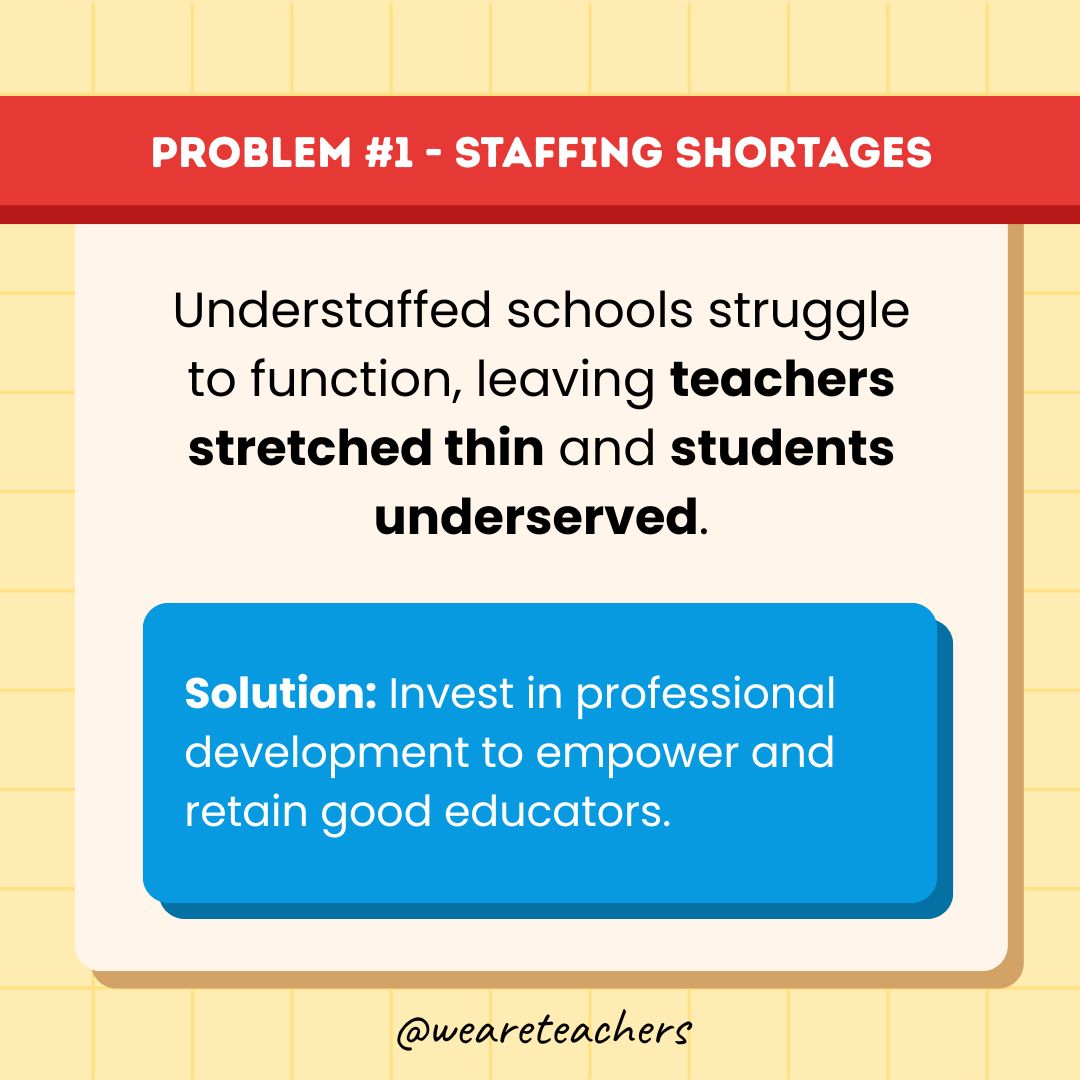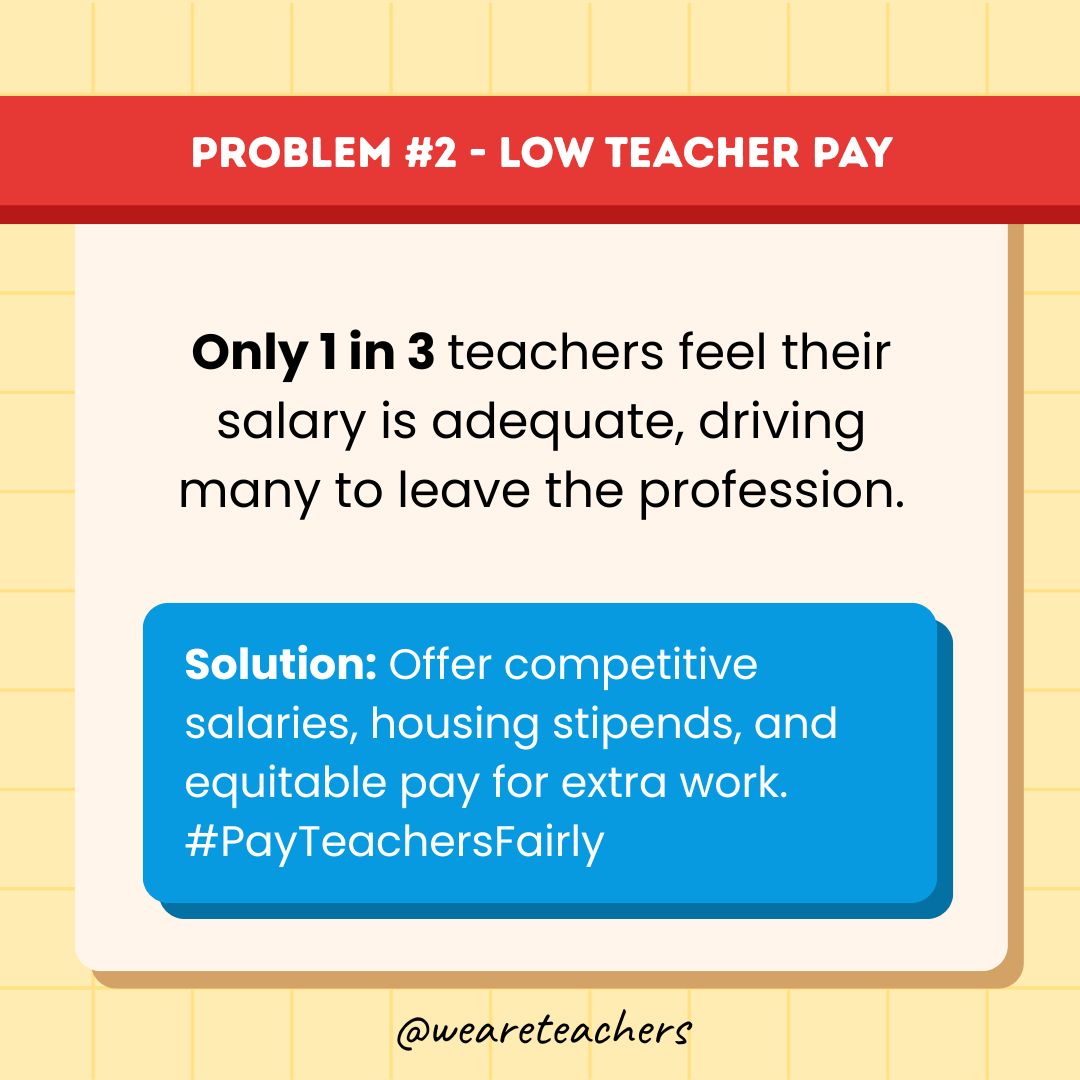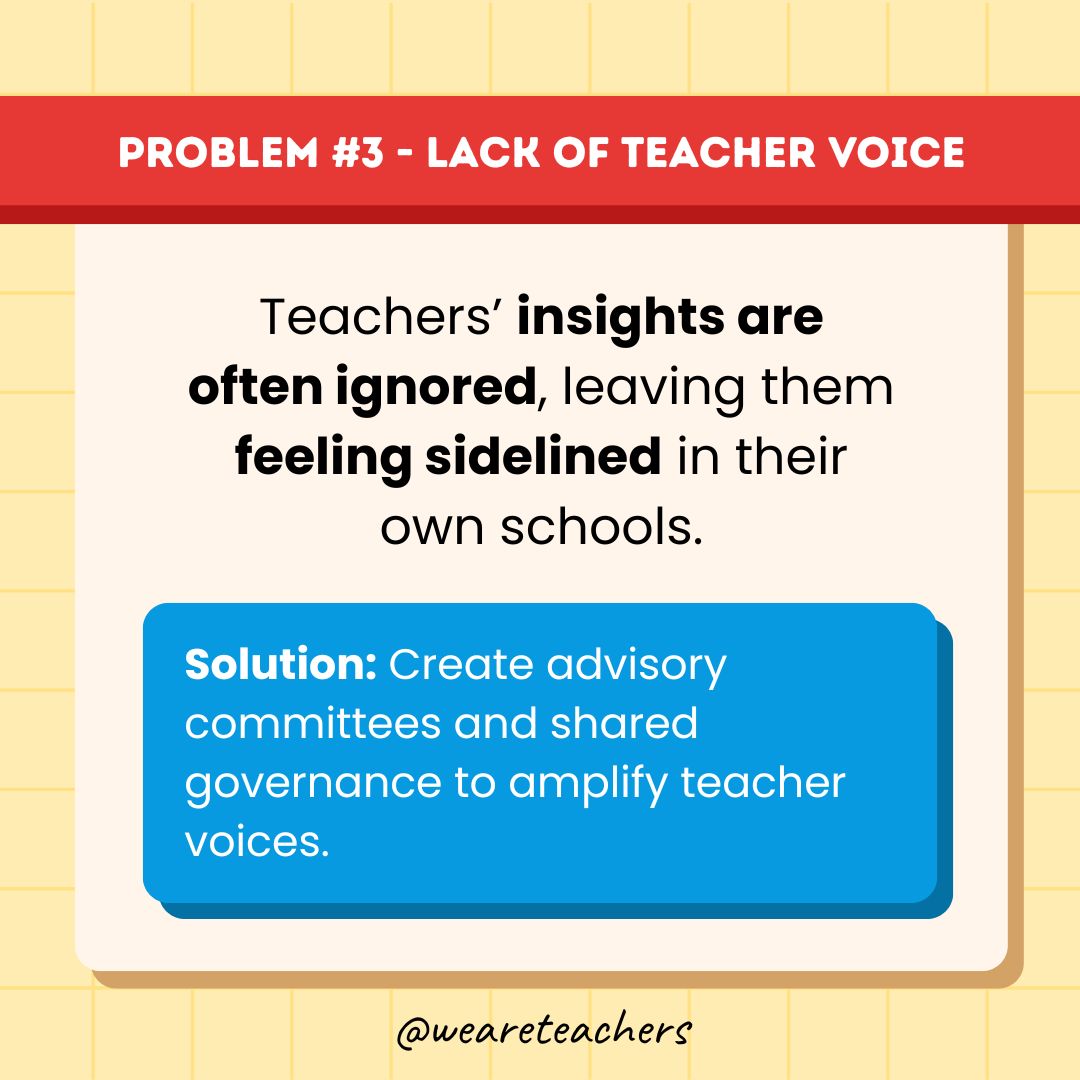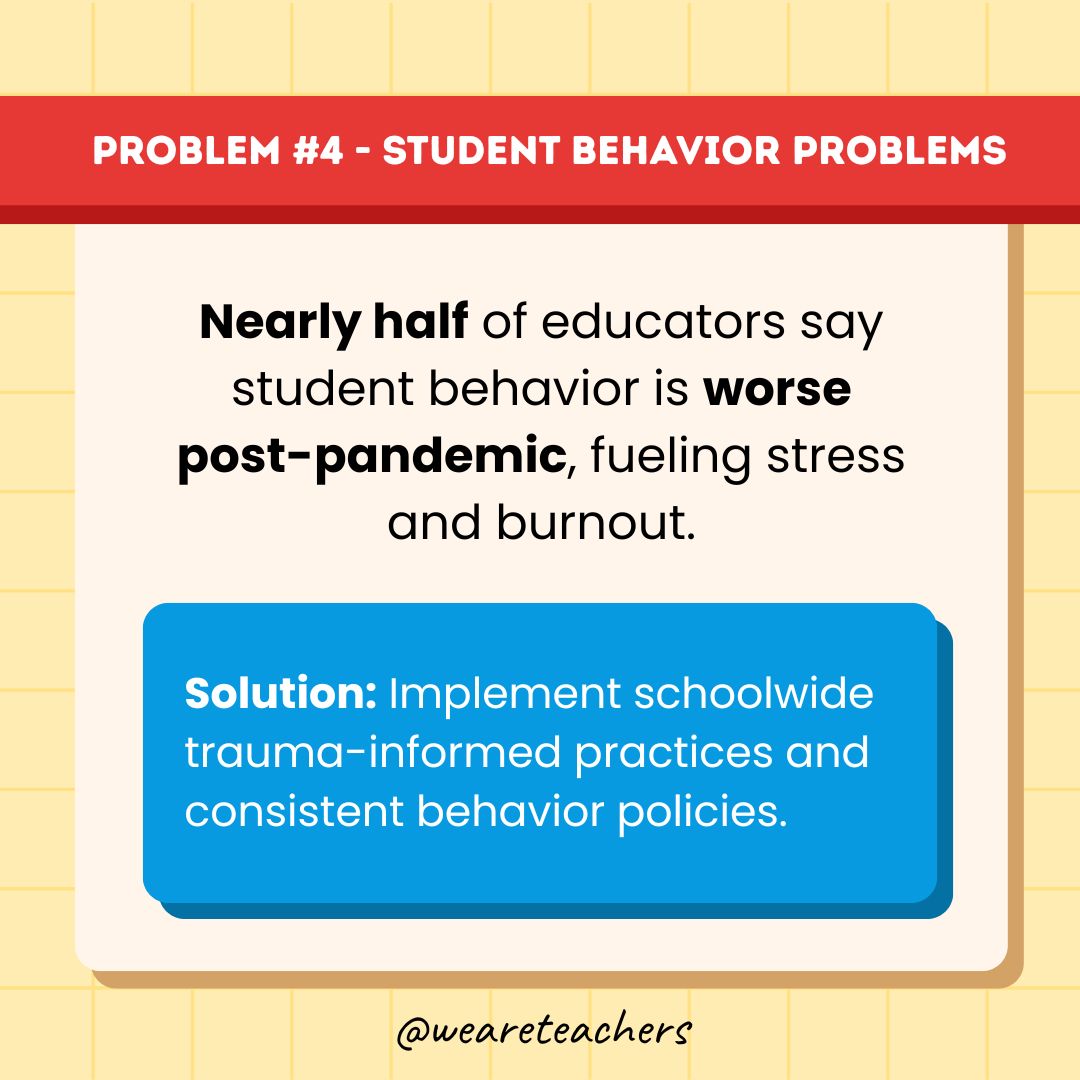We don’t need more think pieces about teacher burnout—we need real action. If we want to keep teachers from quitting, we have to address the conditions that are pushing them out. The reality of what’s in our schools can’t be ignored any longer.
Only about one-third of teachers believe their salary is adequate. Most teachers don’t have enough time during the school day to complete their work and say maintaining work-life balance is nearly impossible. Meanwhile, nearly half of educators report that student behavior is “a lot worse” than it was before the pandemic. Clearly, we need change.
Let’s take a closer look at these numbers, the seven root problems driving educators out of the profession, and what it would actually take to keep them teaching.
Problem 1: Staffing shortages

Almost every school district is grappling with staffing gaps, in the classroom, in the cafeteria, and even on school buses. These shortages make it nearly impossible to run a functional school day, let alone offer the kind of education our kids deserve. While the situation has shown signs of improvement, many schools are still seeing ongoing teacher shortages, particularly in the science and special education fields.
Solution: Invest in support that retains educators
Fixing the pipeline won’t happen overnight, but we can take meaningful steps to retain the educators we have. That starts with professional development and systemic support that go beyond one-off workshops.
Solutions like Conscious Discipline’s professional development training and coaching give teachers the tools to create safe, connected, and inclusive classroom environments. When educators feel equipped, supported, and valued, they’re more likely to stay in their jobs.
Changing the climate and culture from the inside out isn’t just a retention strategy. It’s a foundation for rebuilding the profession.
Problem 2: Low teacher pay

We’ve said it before, and we’ll say it again: Teachers are underpaid and overworked. According to the 2024 State of the American Teacher Survey from RAND, only one in three teachers believe their pay is adequate. Low salaries remain one of the top reasons teachers consider leaving the profession, particularly among Black teachers, who not only report lower base pay but also smaller pay increases and more unpaid extra duties.
Solution: Pay that reflects the work
It’s clear that increasing salaries leads to increased benefits. According to the RAND survey, teachers reported needing at least $16,000 more to feel that their salary was adequate. That’s a lot more than the small raise (around $2,000) most received in 2023–24. Teachers in single-income households are especially burdened, often spending disproportionate portions of their paychecks on essentials like housing and childcare.
Policymakers and school leaders need to do more than offer token raises. Some ways to make a real difference include:
- Ensuring equitable compensation for extra work
- Expanding access to paid parental leave
- Housing stipends and tuition support
- Increasing pay transparency to build trust and fairness
Research also shows that teacher unions make a huge difference. In fact, “teachers in states requiring collective bargaining reported higher salaries and larger pay increases compared with those in states where bargaining is prohibited.”
At the end of the day, paying teachers fairly isn’t just about retention, it’s about recognizing their value. Investing in teacher compensation is investing in the future of education.
Problem 3: Lack of teacher voice

How many of us have made suggestions or expressed concerns only to have them dismissed or ignored? Despite being on the front lines, it often feels like no one wants to hear what teachers have to say. The 2024 Voices From the Classroom report reveals that teachers across the country are calling for more collaborative, dynamic environments and a chance to help shape the profession’s future.
The Pew Research Center’s 2024 survey also found that 84% of teachers don’t have enough time to collaborate or plan, and over half say their voices aren’t reflected in decision-making at the school or district level. Add in the constant disruptions, staffing shortages, and heavy emotional toll, and it’s no wonder morale is at an all-time low.
Solution: Invite us in
We’ve spent years pursuing degrees and professional development. We know our students, our communities, and our content. Haven’t we earned a seat at the table? Teachers bring practical, classroom-informed insights that can make initiatives more effective and sustainable.
When schools and districts elevate teacher voice through advisory committees, shared governance, and teacher-led innovation, everyone benefits:
- Teachers feel valued and heard, which improves morale and retention.
- Decisions are better informed and more likely to succeed.
- Students experience more consistent and responsive instruction.
If we want to reimagine education for the better, we have to start by listening to the people who know it best: teachers.
Problem 4: Student behavior problems

Student behavior challenges have escalated sharply since the pandemic, and they’re not getting better. According to a January 2025 survey by the EdWeek Research Center, 48% of educators said student behavior this school year is “a lot worse” than before the COVID pandemic. Additionally, a recent RAND survey found that “Forty-five percent of teachers overall—and 66 percent of new teachers—said managing student behavior was the most stressful part of their job.”
Teachers report a daily struggle with disrespect, disruptions, defiance, and hallway fights that sometimes spill over into cyberbullying. One survey respondent shared, “Our school is really struggling with student behaviors (lots of disrespect and not following the rules, and teachers are almost too tired to even care.” Even after a full-day PD session on discipline, the respondent said, “I don’t think any of the teachers left feeling hopeful.”
This isn’t just about classroom management—it’s about morale. These persistent issues are contributing to burnout. Without systemic support, many teachers feel like they’re trying to manage it all alone.
Solution: Shared discipline, real support
Managing classroom behavior cannot rest solely on the teacher’s shoulders. Educators need a school-wide system of support that includes:
- Trauma-responsive practices and self-regulation learning tools like Conscious Discipline to help students regulate emotions and build trust
- Clear, consistent school-wide behavior policies that are enforced equitably across classrooms and common areas
- Behavioral support staff who can step in when incidents escalate
- Administrative leadership that backs teachers and promotes a respectful, safe learning environment
- Family partnerships to reinforce behavioral expectations beyond school walls
One bright spot from the EdWeek survey: A small percentage of teachers reported improvements in student behavior due to stronger school leadership. When administrators support teachers with consistency, communication, and clear expectations, positive change is possible.
Problem 5: Lack of respect from parents and admin

Unreasonable workloads, micromanaging, classroom disruptions, and feeling silenced within our own schools—these issues all point to one underlying problem: a lack of respect. During the pandemic, many teachers felt their health and safety were treated as an afterthought. Years later, not much has changed. Teachers still feel dismissed, undervalued, and, in many cases, blamed for issues beyond their control.
According to a 2024 Pew Research Center survey, 17% of teachers specifically said they feel undervalued and disrespected, both by the public and by parents. Others described being treated as though they were unqualified or uneducated—despite holding advanced degrees and working well beyond contracted hours. Some teachers noted that disrespect from families is not only demoralizing but also directly impacts their ability to teach effectively.
One high school teacher said it plainly: “We need to be treated like professionals. We are micromanaged, underpaid, not trusted to do our jobs. We are expected to deal with too many things and are not equipped.” That lack of trust, especially when it comes from both admin and parents, chips away at morale and sends a clear message: We’re not seen as professionals.
Solution: Rebuild respect through trust and partnership
Teachers aren’t asking for applause. We’re asking to be treated like professionals—trusted, supported, and given the space to do our jobs. The path forward includes:
- Administrators actively listening to teachers’ perspectives and involving them in meaningful decisions
- Clear communication between schools and families, with shared expectations and mutual respect
- Public acknowledgment of the demanding, multifaceted nature of teaching, not just during Teacher Appreciation Week, but year-round
- Trust in teacher expertise instead of micromanagement and second-guessing
- Strong home-school partnerships, built on the belief that education is a shared responsibility
As one elementary school teacher put it: “We love your kids and we want the best for them. We spend more time with your kids than with our own kids, so just give us some trust to do right by them.”
Problem 6: No work-life balance

Working overtime is not a badge of honor. Yet, teachers routinely bring work home (grading, planning, emailing, etc.) and end up working well beyond their contracted hours. According to a 2024 Pew Research Center survey, 54% of teachers say it’s very or somewhat difficult to maintain a healthy work–life balance, and 84% say there’s not enough time during their regular work hours to do tasks like grading, lesson planning, paperwork, and answering work emails.
A 2024 RAND study adds that teachers put in an average of 53 hours per week, with 60% reporting burnout, which is well above comparable professions. No wonder many educators feel drained and demoralized.
Solution: Make work-life balance a priority
To retain teachers, schools must model and mandate healthy boundaries:
- Enforce no after-hours emails and encourage disconnection.
- Ensure protected planning time during school hours.
- Provide wellness support like mental health services and staff retreats.
- Model healthy leave-taking, signaling that teachers deserve (and should use!) their time off.
When work-life balance becomes institutional rather than optional, we create schools where teachers can comfortably teach and live.
Problem 7: Poor management or leadership

All the problems we’ve highlighted—staffing shortages, behavior issues, micromanagement, burnout—trace back to poor leadership. Teachers often feel like no one has their back. Inconsistent expectations, under-resourced classrooms, unpredictable conditions, and threats to well-being thrive when management is weak.
Without strong leadership, why would teachers feel any loyalty to stay in the profession? How can change happen when basic needs aren’t being met and guidance isn’t coming from the top?
What does the research say?
- University of Memphis (May 2025): A qualitative study found that principals who emphasize servant or transformational leadership, focusing on communication, support, and trust, significantly improve teacher morale and retention, especially in urban schools.
- Journal of Educational Leadership and Policy Studies (Spring 2024): Interviews with 12 high-retention school leaders flagged supportive administration and positive school culture as top drivers for keeping staff—over all other factors.
- Taylor & Francis Online (2024): A meta-review of 96 studies confirmed that strong school leadership is a central factor in teacher retention, more so than workload or policies.
- Nature (2025): A recent experiment in Pakistan linked participatory leadership, where teachers contribute in decision-making, to higher teacher retention, suggesting truly collaborative leadership reduces attrition.
- Learning Policy Institute (September 2024): Report notes that manageable workloads and robust administrative support are the top fixes for teacher burnout and turnover.
Solution: Leadership that shows up for teachers
Transformative leadership isn’t just a buzzword—it’s what makes teachers and schools thrive. Effective leadership keeps teachers teaching. That means:
- Principals and admin who uplift and connect
- Shared leadership where teacher voices shape practice
- A healthy school culture rooted in trust and teamwork
- Strategic support, planning time, coaching, and resources
- Continuity of leadership to maintain trust and momentum
When leadership works with teachers rather than above or against them, the entire school ecosystem flourishes.
Reignite your passion for teaching and improve teacher retention with Conscious Discipline:
Face burnout head-on with on-site or virtual training designed to refresh, restore, and rekindle your love for teaching. Start exploring supportive training options today!



